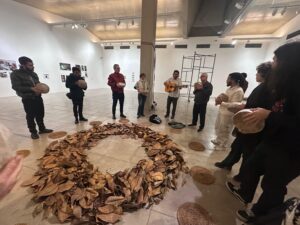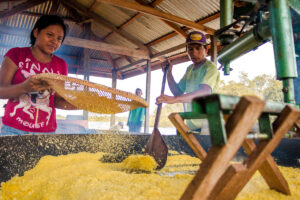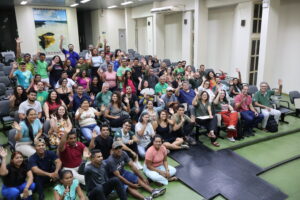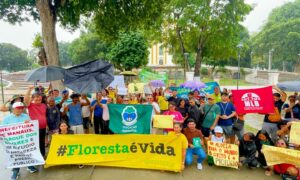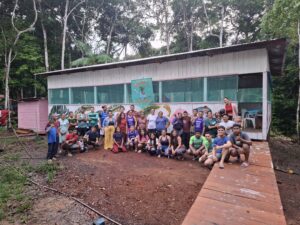By: Nathália Messina
On May 8, 9 and 10, 2025, we experienced a historic moment in Carauari (AM), celebrating the resistance and wisdom of riverine communities: the holding of the 1st Fair for the Commercialization of Community-Raised Chelonians in the Médio Juruá. More than just a fair, the event represented a milestone in a new chapter for the conservation of Amazonian sociobiodiversity and for the recognition of the families directly involved in this work.
Photo: Communication Department of SEMA and IPAAM.
This is the first time, in Amazonas and in Brazil, that the sale of community-raised chelonians has been authorized by an environmental licensing agency, IPAAM – the Institute of Environmental Protection of Amazonas. After decades of monitoring the tabuleiros (sandy nesting plateaus), beaches and nesting sites of chelonians, in the RDS (Sustainable Development Reserve) Uacari – managed by the State of Amazonas – and the RESEX (Extractive Reserve) Médio Juruá – managed by the the federal government -, and the fight for environmental justice and the recognition of the monitors takes another step forward in history.
The state RDS Uacari Reserve achieved the right to legally commercialize animals raised in excavated tanks — a groundbreaking and highly significant achievement. Approximately one thousand chelonians (Amazon river turtles and tracajás) raised by families from the Manarian, Vila Ramalho, and Xibauazinho communities were transported for commercialization. The sale followed strict technical and legal criteria, with support from the Pé de Pincha Program (UFAM – Federal University of Amazonas), ensuring that each animal had the adequate weight (minimum 1.5 kg) and was identified with official seals and authorized receipts. The proceeds were distributed among approximately 51 families involved, strengthening the local economy and encouraging the continued protection of natural nesting environments.
The protection of tabuleiros (sandy nesting plateaus) used by chelonians is very important, as it is a highly effective conservation effort that involves great dedication from the monitors responsible for these areas. According to Eduardo Muhlen (Duka), Territorial Governance and Socio-bioeconomy Coordinator at Instituto Juruá: “Chelonian conservation faces several challenges! Instituto Juruá has been working together with AMARU (Association of Agroextractive Residents of the Uacari Sustainable Development Reserve), AMECSARA (Association of Extractive Residents of the São Raimundo Community), SEMA-AM (State Secretariat for the Environment of Amazonas), ICMBio (Chico Mendes Institute for Biodiversity Conservation), Pé de Pincha, and the communities of the Uacari RDS and Médio Juruá RESEX to support the protection of 19 tabuleiros in Carauari, in the region of the Conservation Units — and not only to ensure species conservation, but also to promote dignity and recognition for the monitors’ work, as well as food security and sovereignty, since we also understand that chelonians are important elements in local food culture. And possibly, one way for communities to minimize the illegal chelonian trade is through this solution of community-based farming.”, reported Eduardo. Thus, alongside these partners, we have been providing technical-scientific, logistical, and institutional support so that this community-based initiative can flourish.
Paraphrasing Professor Paulo Andrade (Pé de Pincha), chelonian conservation in the Médio Juruá region is not recent: it has involved more than 45 years of voluntary community vigilance, ensuring that thousands of hatchlings return to nature every year. Today, over 165 sites across Amazonas protect around 1.7 million hatchlings annually, and more than 80% of these actions are led by local communities, according the professor – one of the leading authorities on the subject in Amazonas.
And as Hugo Costa, our scientific research coordinator at IJ, stated, “the turtle acts as an umbrella species. By protecting the tabuleiros for the chelonian reproduction, we are also protecting all the associated ecosystem migratory birds, armored catfish, caimans, and insects. It is a great environmental service provided by those who live in the forest.” But this effort is still not matched by a proportional return to the protector families. That’s why the legalization of the raising and commercialization is also a justice strategy: a concrete recognition that community-based socioenvironment conservation must promote a dignified life to the monitoring families.
The fair, therefore, served as the culmination of the entire protection process. May 8th was especially vibrant: a festival of culture, art, flavors, and knowledge. In addition to the official opening, which honored the chelonian monitors and featured speeches from the attending authorities — including the State Secretary for the Environment, Eduardo Taveira, and the Mayor of Carauari, Airton Siqueira, the public also enjoyed the photo exhibition “Chelonians and Amazonian Communities: Médio Juruá in focus”; watch a live painting led by community artist Elissandro da Silva Cunha, from the Fortuna community; taste traditional dishes made with chelonians; and purchase handicrafts made by local organizations connected to the Médio Juruá Territory Forum.



On May 9 and 10, the event was exclusively dedicated to the direct sale of chelonians, initially at the Braulino Maia Sports Court (Carauari Waterfront) and later at the Beira-Mar Round Market. According to data provided by Gilberto Olavo (manager of the Uacari Sustainable Development Reserve), the communities brought 979 chelonians, including turtles and tracajás (a species of freshwater turtle native to the Amazon region), totaling a little over 2 tons (2,207.3 kg), all of which were sold at the price of R$20.00. This price was only possible due to subsidies provided by the Carauari Municipal Government, in the amount of R$5.00, and by Instituto Juruá, in the amount of R$15.00; otherwise, the sale price would have been around R$40.00, considering production and transportation costs. The total amount generated, considering the subsidies, was R$88,292.00, distributed among all participating communities and grassroots organizations. All results will be detailed in the report that AMARU is preparing for IPAAM, as part of the licensing process.
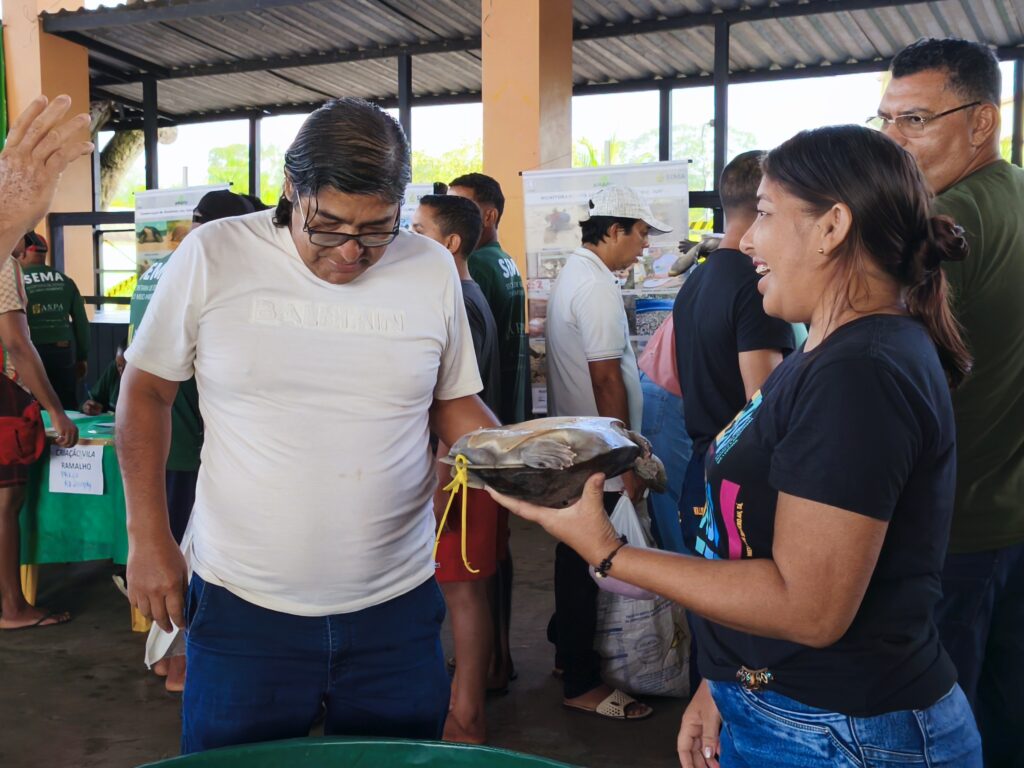

This historic event was carried out by the communities themselves of RESEX Médio Juruá and RDS Uacari, in partnership with SEMA-AM, ICMBio, UFAM (Pé-de-Pincha), AMARU, AMECSARA, and Instituto Juruá, with support from Ibama, the Carauari City Hall, FAS, Natura, ASPROC, and the Médio Juruá Territory Forum. The authorization was granted by IPAAM-AM, crowning a struggle that began decades ago.
Photo: Paulo Andrade.
The fair showed that it is possible to unite forest and city, tradition and innovation, conservation and community well-being. We continue strong, side by side with the communities and partners, for a living Amazon!

